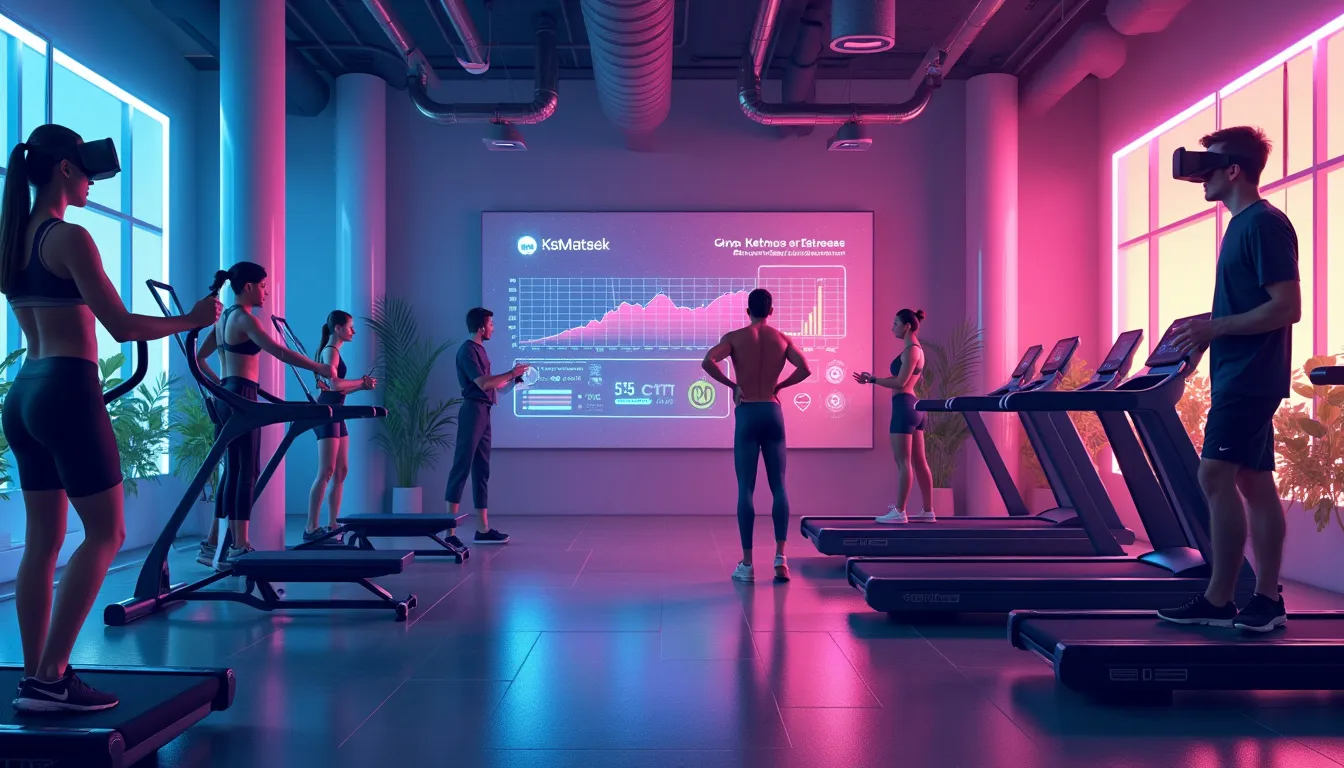In today’s fast-paced world, maintaining fitness and health has never been more critical—or more challenging. Amid hectic schedules and endless responsibilities, finding the time and motivation to stay active can feel like a Herculean task. Fortunately, leveraging technology for fitness and health presents a modern solution to this age-old problem, transforming the way we approach our physical well-being. Over the past decade, rapid advancements in technology have made fitness tools more accessible and effective than ever before, ensuring that anyone can embark on a health journey that’s tailored to their unique needs and lifestyles.
Wearable devices like smartwatches and fitness trackers are ubiquitous, offering real-time data on everything from heart rates to sleep patterns, while fitness apps provide a comprehensive suite of tools for tracking diet, exercise, and progress. Home fitness equipment has evolved to include smart home gyms and advanced exercise machines that replicate the experience of a professional training facility. Moreover, virtual fitness classes and training programs have democratized access to world-class instructors and diverse workouts, allowing people to engage in high-quality exercise from the comfort of their homes.
These technological innovations do more than just facilitate workouts; they also offer personalized exercise plans, track real-time data, and enhance motivation through social features and reminders. Whether it’s through customizing workouts to fit individual goals or offering on-demand resources for remote workouts, technology has made fitness more accessible and convenient.
Looking ahead, the integration of Artificial Intelligence (AI) and Machine Learning (ML) promises to deliver even more tailored health insights. Advances in Virtual Reality (VR) are set to create immersive, engaging fitness experiences, while emerging health monitoring tools like advanced biosensors and telehealth are poised to revolutionize how we track and manage our health. As technology continues to evolve, its impact on the fitness industry is likely to grow, ushering in an era where achieving optimal health and fitness is as seamless and intuitive as using your smartphone.
So, why not embrace these advancements? Leverage technology for fitness and health today, and take the first step toward a healthier, more active lifestyle.
Introduction to Leveraging Technology for Fitness and Health
Maintaining good fitness and health has never been more important. As our lives become increasingly hectic and sedentary, prioritizing physical well-being is crucial. The integration of technology into our fitness routines offers new opportunities to stay active and healthy. Leveraging technology for fitness and health has become a game-changer, reshaping how we approach our exercise and wellness goals.
The role of technology in modern fitness and health can hardly be overstated. Gone are the days when exercise was purely about lifting weights or jogging around the block. With the advent of smart devices, mobile apps, and intelligent equipment, technology now plays a pivotal role in helping individuals monitor, manage, and enhance their fitness regimens.
Over the past decade, we’ve witnessed a rapid advancement in fitness technologies, making them more accessible and user-friendly than ever before. Whether it’s a fitness tracker recording every step you take, or a sophisticated app providing dietary advice based on real-time data, the tools available today are designed to support a healthier lifestyle tailored to your unique needs.
To illustrate, let’s consider the impact of wearable devices. Not too long ago, tracking your heart rate during exercise required bulky equipment and often a visit to a health professional. Today, it’s as simple as strapping on a smartwatch or fitness tracker. These devices give you immediate feedback not just on your heart rate, but also on the number of calories burned, distance covered, and even your sleep patterns. Such detailed analysis enables users to make informed adjustments to their routines, promoting better overall health.
Moreover, the accessibility of these technologies has improved dramatically. What was once the domain of tech enthusiasts and professional athletes is now available to the everyday user. With a multitude of price points and functionalities, there is something for everyone. This democratization of fitness technology ensures that more people, regardless of their background or fitness level, can take proactive steps toward their health and wellness goals.
In my own journey, balancing the challenges of ADHD and OCD while striving to maintain a healthy lifestyle, technology has been an invaluable ally. For instance, using a fitness app to establish structured workouts has provided a sense of routine and predictability, which is essential for managing my ADHD. Additionally, real-time data tracking has offered the consistent feedback necessary to stay motivated, a crucial factor when dealing with the impulsivity associated with ADHD. These personal experiences underscore the transformative potential of leveraging technology for fitness and health.
From a broader perspective, the rapid advancements and expanding accessibility of fitness technology play a fundamental role in encouraging healthier lifestyles on a societal level. Innovative solutions are popping up everywhere, from smart home gyms equipped with interactive screens to fitness apps that provide personalized meal plans and training schedules. These technologies not only make exercising more efficient and enjoyable but also help bridge the gap for those who may find it challenging to incorporate traditional fitness routines into their lives.
As we delve deeper into the various technologies enhancing fitness and health, we’ll explore how wearable devices, fitness apps, home fitness equipment, and virtual training programs are revolutionizing the way we approach physical activity. By leveraging these technologies, we can optimize our workouts, track progress in real-time, and, ultimately, achieve a higher quality of life. The aim is to make fitness more accessible, engaging, and effective for everyone, regardless of their starting point.

Popular Technologies Enhancing Fitness and Health
In today’s digital age, leveraging technology for fitness and health has become an integral part of our daily routines. With an array of gadgets and applications designed to support and enhance our fitness journeys, there’s never been a better time to integrate tech into your health regimen. Here are some of the most popular technologies that are making a significant impact:
Wearable Devices: Smartwatches, Fitness Trackers
Wearable devices have revolutionized how we monitor our physical activity and health metrics. From smartwatches to fitness trackers, these gadgets provide real-time data on steps taken, heart rate, sleep patterns, and even stress levels. Take, for example, the Apple Watch, which not only tracks your workouts but also offers guided breathing exercises to help manage stress. Similarly, Fitbit devices offer detailed insights into your sleep quality and activity levels, pushing you to be more mindful of your overall health.
Fitness Apps: Comprehensive Fitness and Diet Tracking Applications
Fitness apps are another cornerstone in the landscape of leveraging technology for fitness and health. Apps like MyFitnessPal and Strava allow users to log their workouts, track their caloric intake, and monitor their nutritional intake. These applications often integrate with wearable devices and other platforms, offering a seamless experience. As someone who has battled with weight loss, I can attest to the transformative power of these apps. Logging meals and workouts helps maintain accountability and provides a clear picture of progress and areas for improvement.
Home Fitness Equipment: Smart Home Gyms and Advanced Exercise Machines
Home fitness equipment has also seen significant advancements, making it easier to get a quality workout without leaving the house. Smart home gyms like Peloton and Mirror offer interactive training experiences, competing with the traditional gym setting. These machines often come with large screens that stream live or pre-recorded workout classes, and some even provide real-time feedback and adjustments based on your performance. This means no more excuses for skipping a workout because of a busy schedule or inclement weather.
Virtual Fitness Classes and Training Programs
The COVID-19 pandemic accelerated the adoption of virtual fitness classes and training programs, a trend that shows no signs of waning. Platforms like Zoom and specialized fitness apps allow users to join live classes or follow along with recorded sessions from the comfort of their home. This has opened up a world of fitness opportunities, making diverse workout styles and expert trainers more accessible than ever before. As someone managing ADHD and OCD, the flexibility of virtual fitness classes ensures I can find an instructor and workout style that align with my needs and preferences, making it easier to stick to a consistent fitness routine.
Incorporating these technologies into your fitness regimen can help you maintain motivation, track progress, and ultimately achieve your health goals. By understanding and leveraging these popular technologies, you can take significant strides in enhancing your fitness journey.

Benefits of Using Technology in Fitness and Health
Personalized Exercise Plans: Customizable Workouts Based on Individual Needs
Leveraging technology for fitness and health has revolutionized the way we approach exercise routines. Gone are the days of generic workout plans that may or may not suit individual needs. Modern technologies, especially AI-powered fitness apps, have made it possible to create highly personalized exercise plans. These tools consider various parameters such as age, fitness levels, body metrics, and personal goals. For instance, apps like MyFitnessPal or Fitbit’s workout platform allow users to enter their data and receive tailored workout routines. This personalized approach maximizes the effectiveness of fitness plans, ensuring that users get the most out of their workouts.
Real-Time Data Tracking: Monitoring Progress, Heart Rate, Calories
The advent of real-time data tracking in fitness technology cannot be overstated. Wearable devices such as smartwatches and fitness trackers provide immediate feedback on numerous parameters, including heart rate, calories burned, steps taken, and even sleep quality. By continuously monitoring these metrics, users can adjust their activities on the fly to optimize results. Consider an example from my own journey—struggling with ADHD and OCD has often meant that maintaining a consistent routine is challenging. However, with real-time data at my fingertips, I’ve been able to keep track of my progress and stay on course, which has been a game-changer in managing both my fitness and mental health effectively.
Enhanced Motivation and Accountability: Social Features and Reminders
One of the most common hurdles in maintaining a fitness routine is motivation. Technology has tackled this issue head-on through social features and reminders. Fitness apps often include community groups, social sharing options, and even friendly competition with other users, which significantly boosts motivation. For example, platforms like Strava allow users to share their workout achievements and challenge friends, creating a sense of accountability. Additionally, regular reminders and notifications ensure that users stay committed to their fitness goals. Personally, dealing with ADHD has meant that reminders and scheduling are crucial to staying focused, and having tech tools prompt me to stay active has been invaluable.
Accessibility and Convenience: On-Demand Resources and Remote Workouts
One of the most compelling benefits of leveraging technology for fitness and health is the unparalleled accessibility and convenience it offers. In today’s fast-paced world, finding time to hit the gym can be a struggle. However, technology bridges this gap by providing on-demand resources and remote workout possibilities. Platforms like Peloton and Beachbody On Demand offer a plethora of workouts accessible from the comfort of your home. This is particularly beneficial for those who may feel intimidated by gym environments or have to navigate various personal challenges like managing weight loss journeys. I can attest that the ability to access high-quality fitness sessions from anywhere has made fitness a more attainable goal despite packing a tight schedule.

Future Trends in Fitness and Health Technology
The landscape of fitness and health technology is ever-evolving, with innovations promising to transform how we approach our well-being. As we look to the future, several key trends are set to redefine the industry, making it more personalized, immersive, and efficient. By leveraging technology for fitness and health, we can anticipate the following advancements:
Integration of Artificial Intelligence (AI) and Machine Learning (ML) for Tailored Health Insights
The power of AI and ML is unlocking new potentials in fitness and health. These technologies can analyze vast amounts of data to provide insights that are both specific and actionable. Imagine a virtual coach that understands your body better than you do, adjusting your exercise regimen in real-time based on your unique needs and goals. For instance, AI-powered platforms like MyFitnessPal and Noom use algorithms to suggest diet and workout plans tailored to individual users, enhancing the effectiveness of their fitness journey.
AI and ML also play a crucial role in predictive analytics. They can anticipate potential health issues by analyzing patterns in data from wearables or smartphones, allowing for proactive measures. This is not just about predicting whether you’re likely to skip a gym session; it’s about recognizing trends that could indicate serious health concerns and providing timely interventions. The integration of these technologies is paving the way for a future where fitness and health are not only more personalized but also far more preventive.
Advances in Virtual Reality (VR) for Immersive Fitness Experiences
Virtual Reality (VR) is no longer confined to the realms of gaming and entertainment; it is making significant inroads into fitness and health. VR workouts offer an immersive experience that can transform mundane exercise routines into adventures. Imagine running through a scenic landscape or boxing in a futuristic arena—all from the comfort of your home.
Platforms like Supernatural and FitXR are already offering VR-based fitness classes, making workouts more engaging and enjoyable. These platforms leverage the immersive nature of VR to keep users motivated, transforming fitness from a chore to an exciting part of their day. The ability to transport users to different environments can also serve as a powerful tool for mental health, offering a form of escapism and stress relief.
The future of VR in fitness looks even more promising with advancements in haptic feedback technology, which will make these virtual experiences feel incredibly real. Combine this with AI, and you have a recipe for highly personalized and deeply engaging fitness regimens.
Emerging Health Monitoring Tools: Advanced Biosensors and Telehealth
Health monitoring is becoming increasingly sophisticated, thanks to advanced biosensors that can track a plethora of metrics—beyond just steps and heart rate. Innovations in this space include sensors that monitor glucose levels, hydration, and even mental stress. Companies like WHOOP and Oura are at the forefront, providing wearables that offer comprehensive health insights.
Biosensors can also be integrated into everyday items, from smart clothing to sleep monitors, delivering continuous health data that can be analyzed in real-time. This level of monitoring can help in early detection of health issues, allowing for timely interventions and more effective management of chronic conditions.
Moreover, telehealth is revolutionizing the way we access healthcare. Remote consultations and virtual healthcare services are becoming the norm, breaking down geographical barriers and making healthcare more accessible. For individuals with busy schedules or those living in remote areas, this is a game-changer. Telehealth platforms are increasingly incorporating AI to provide initial diagnoses and treatment recommendations, further streamlining the process.
Predictions on the Evolution and Impact of Technology in the Fitness Industry
The future of fitness and health technology is brimming with possibilities. As AI, VR, and biosensors continue to evolve, they are set to become more integrated into our daily lives, making fitness and health management seamless and more effective. Here are some predictions:
- Hyper-Personalization: With AI and ML, fitness and health plans will become increasingly tailored to individual needs, preferences, and goals. This will drive better adherence and outcomes.
- Ubiquitous Health Monitoring: Advanced biosensors will be embedded in a wide range of devices, providing continuous health monitoring that’s as natural as wearing a watch.
- Virtual Wellness Communities: As VR becomes more widespread in fitness, we will see the rise of virtual fitness communities where people can work out together, share experiences, and stay motivated, regardless of physical location.
- Preventive Healthcare: The combination of real-time data, predictive analytics, and telehealth will shift the focus from reactive to preventive healthcare, enabling earlier interventions and better health outcomes.
By leveraging technology for fitness and health, we are not just enhancing our physical well-being but also addressing mental and emotional health, creating a holistic approach to wellness. The future is indeed bright, with technology at the helm, guiding us toward a healthier and more balanced life.
As we traverse the landscape of technological advancements in fitness and health, the convergence of innovation and well-being becomes palpably clear. The significance of maintaining fitness and health cannot be overemphasized, and technology has become an indispensable ally in this quest. From wearable devices that track our every move to fitness apps that tailor every workout to our unique needs, the options are vast and incredibly accessible.
The modern fitness enthusiast is spoilt for choice; smartwatches and fitness trackers provide real-time data, while comprehensive fitness apps offer tailored exercise and nutrition plans. Advanced home fitness equipment brings the gym right to our living rooms, enabling us to pursue our health goals regardless of our schedules. Virtual fitness classes and training programs break geographical barriers, connecting us with trainers and fitness communities worldwide.
The benefits of these technologies are manifold. Personalized exercise plans ensure workouts are optimized for individual capabilities and goals, while real-time data tracking keeps us informed and enables timely adjustments. Enhanced motivation and accountability features—such as social sharing, gamification, and reminders—help us stay committed. Furthermore, the accessibility and convenience of on-demand resources have revolutionized the way we approach fitness, making it easier than ever to integrate healthy habits into our daily lives.
Looking ahead, the future of fitness technology is incredibly promising. Artificial Intelligence and Machine Learning are set to deliver even more personalized health insights, adapting and evolving with our needs. Virtual Reality holds the potential to turn mundane workouts into immersive experiences, making fitness not just a necessity but an adventure. Emerging health monitoring tools, bolstered by advanced biosensors and telehealth services, will soon offer unprecedented insights into our physical conditions, facilitating proactive health management.
Yet, as we ride this wave of technological progress, it’s crucial to remember that the ultimate goal is a balanced, healthy life. Technology should serve as an enabler, not a crutch. By leveraging these innovations, we can overcome challenges—be they personal, like managing ADHD or OCD, or communal, like promoting healthy lifestyles—more effectively. With diligence and informed choices, we can navigate the complexities of the modern world and achieve our health aspirations.
So, let’s embrace these technological marvels not just as tools, but as partners in our journey towards enhanced fitness and health. Equip yourself with the right tools, fuel your persistence with data-driven insights, and most importantly, commit to a future where technology and wellness go hand in hand. In doing so, you’ll not only improve your physical and mental well-being but also inspire those around you to embark on their own journeys towards a healthier, happier life.
Support Us: Check out our recommended products on Amazon.

